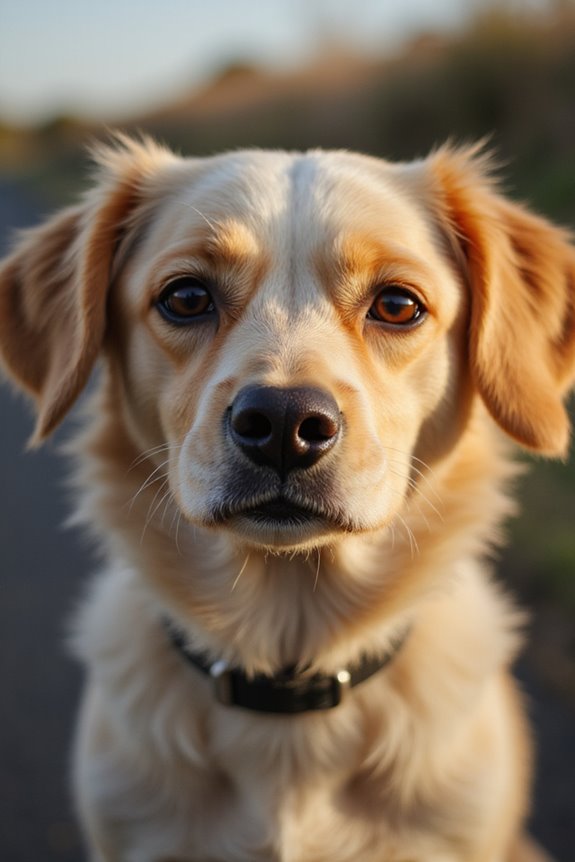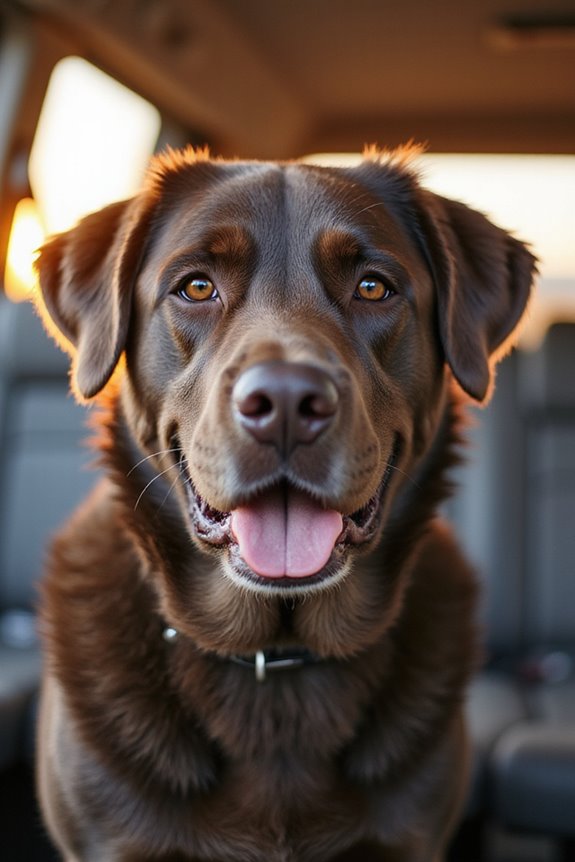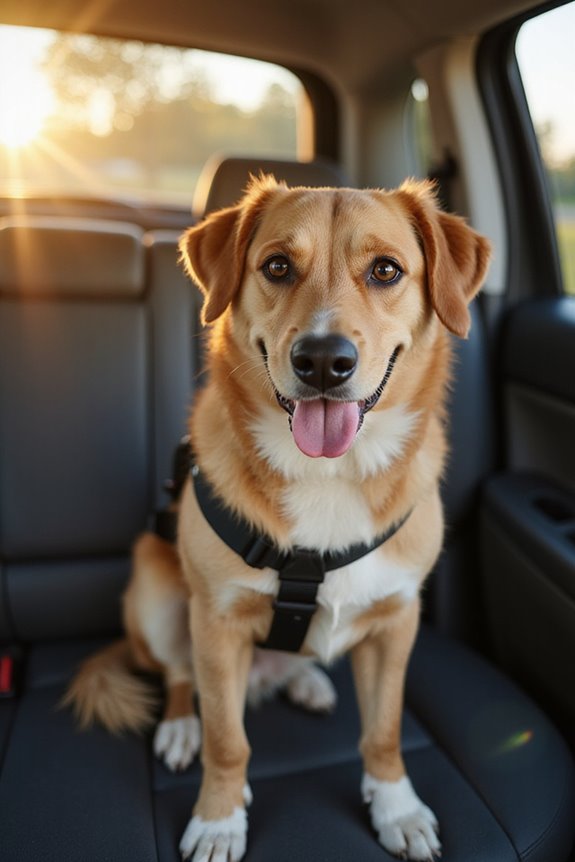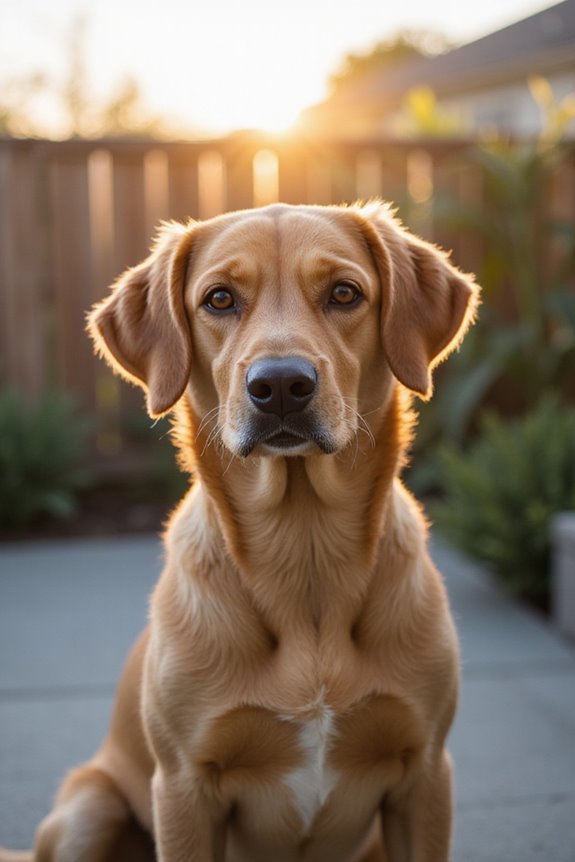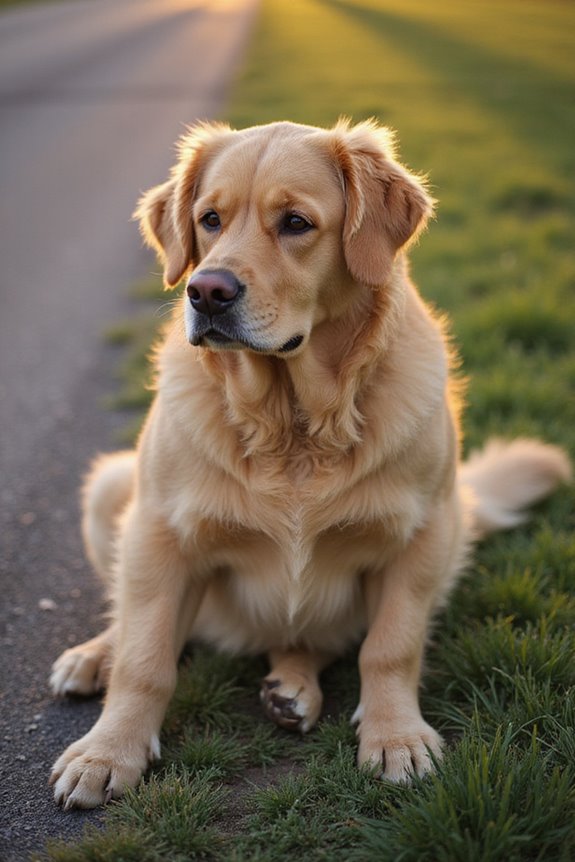To travel safely with small dogs, I make certain I prepare meticulously. I use crash-tested harnesses and secure them in the back seat, preventing distractions. Familiar items like toys help reduce anxiety. For air travel, I verify carrier requirements and book in advance. I also prepare for costs, like airline fees and accommodations. Having a plan for potential emergencies is essential. There are many important steps to take into account, so let’s explore each aspect in detail.
Key Takeaways
- Use a crash-tested harness or secure crate to safely restrain your small dog during car travel.
- Pack pre-portioned meals, treats, and familiar items to ensure your dog’s comfort and reduce anxiety.
- Regularly check and adjust restraints for comfort, especially during long trips.
- Monitor your dog’s body language and take breaks if signs of anxiety arise.
- Confirm airline pet policies, including carrier requirements and potential fees, for safe air travel.
Preparing for Travel With Small Dogs
When preparing for travel with small dogs, careful organization and attention to detail can greatly enhance the experience for both you and your pet. Here are some packing essentials to take into account for smoother travel routines:
- Pre-portioned meals and treats: Use airtight containers to keep food fresh.
- Collapsible bowls: These save space and provide easy access to food and water.
- Medications and supplements: Bring all necessary health-related items.
- Extra gear: Pack a backup collar, leash, and seatbelt harness for safety.
- Familiar items: Including favorite toys and blankets can reduce stress.
Moreover, verify your dog’s collar has up-to-date ID tags, and you’ll want to document microchip information. Preparing ahead helps create a comfortable journey for us both. Additionally, consider investing in a safety feature dog car carrier to ensure your pet’s security during travel.
Safety Measures for Car Travel
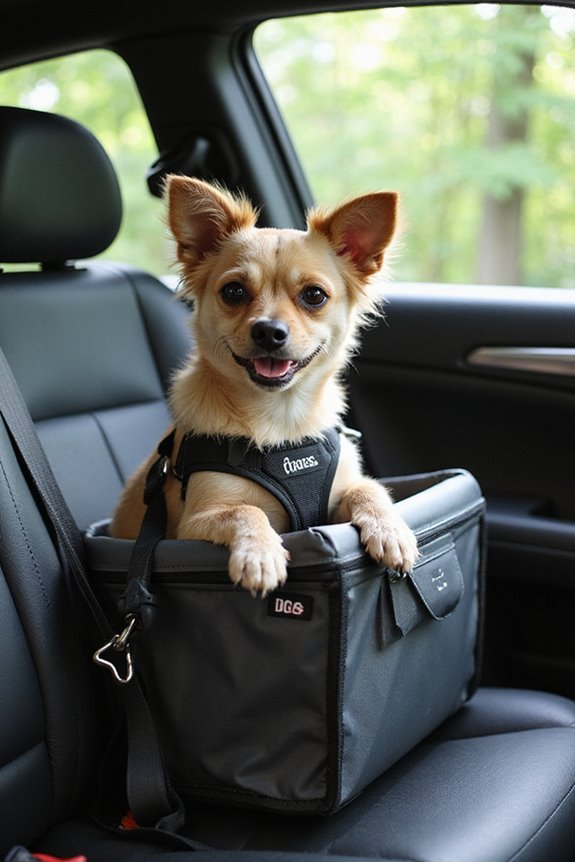
Ensuring your small dog’s safety during car travel is paramount, especially given the potential hazards present in a moving vehicle. To protect your furry companion, consider the following restraint options:
- Crash-Tested Harnesses: Use a harness that attaches to the seatbelt, ensuring secure restraint without risking neck injuries.
- Padded Platforms: These can be secured with a seatbelt plus harness strap, creating a stable environment.
- Carriers: Opt for crates or carriers strapped in with a seatbelt to prevent shifting.
For seating recommendations, always place your dog in the back seat. Avoid front seat travel to reduce distractions. Remember, keeping your pet secure safeguards both of you during your travels. Regularly check that all restraints are secure and comfortable. Additionally, using a dog car seat can further enhance your pet’s safety and comfort during long trips.
Managing Anxiety and Behavioral Issues
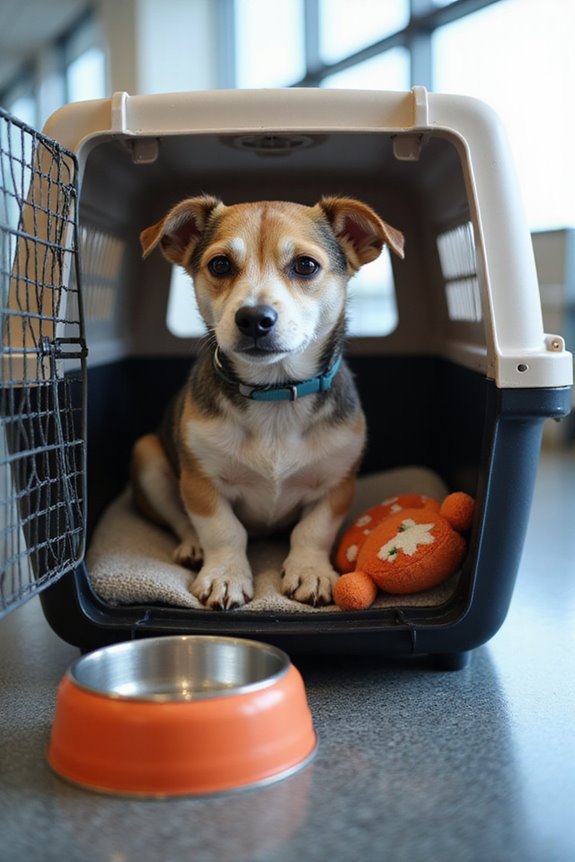
Traveling with a small dog can often be a source of anxiety for both the pet and the owner, so it’s essential to implement effective strategies for managing these behavioral issues. Recognizing anxiety triggers, like car noises or movement, allows for gradual desensitization. Start by breaking these stimuli into manageable parts, using treats to create positive associations.
Incorporate calming techniques such as:
- Teaching a “settle” cue at home.
- Using Dog Appeasing Pheromones or calming sprays.
- Ensuring a quiet travel environment to minimize stress. Additionally, consider using products like calming pheromone diffusers to provide a soothing atmosphere during travel.
Always monitor your dog’s body language; if you see signs of distress, pause the journey. By maintaining a calm demeanor and addressing anxiety proactively, you can help your dog enjoy travel as much as you do.
Considerations for Air Travel
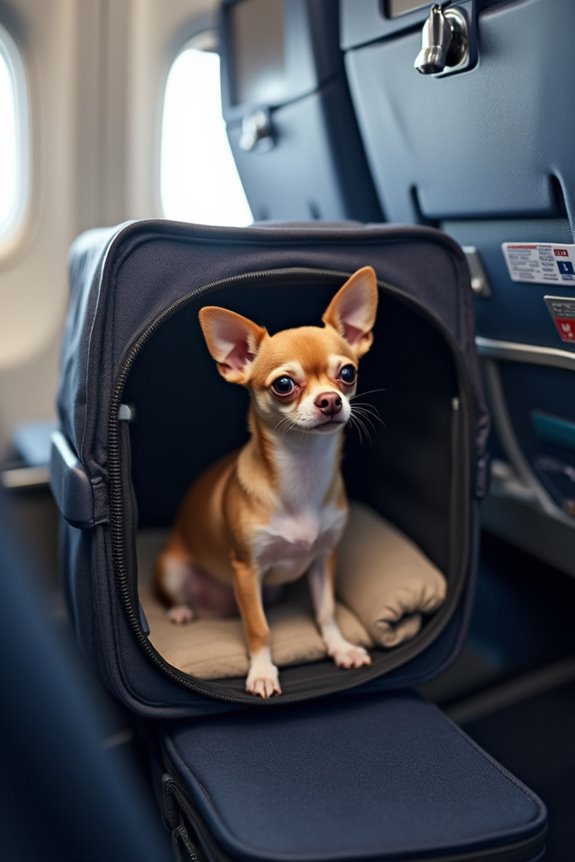
As I prepare for air travel with my small dog, it’s essential to understand the various considerations involved to confirm a safe and comfortable journey for both of us. Here are key points to keep in mind:
- Airline Policies: Each airline has its own rules, so I’ll verify specific pet carrier dimensions since my dog must fit under the seat in an airline-approved carrier.
- Pet Carriers: They must be leak-proof, secure, and spacious enough for my dog to stand, turn, and lie down.
- Health Checks: A pre-flight vet visit confirms my dog is fit for travel, along with necessary vaccination documents.
- Reservations: I’ll book in advance as airlines limit pets per flight and confirm any breed restrictions, especially for snub-nosed breeds.
Cost Planning for Traveling With Pets
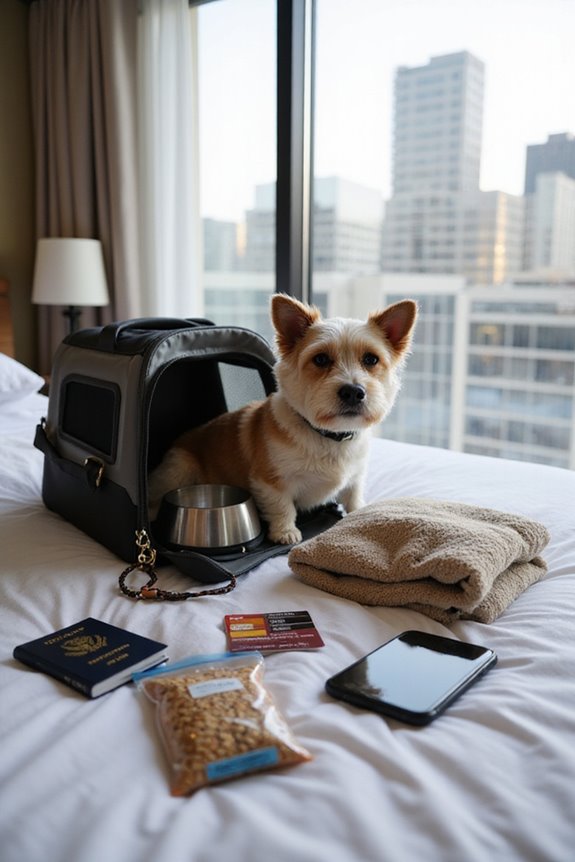
When planning for a trip with your small dog, it’s crucial to take into account various costs that can quickly add up and impact your budget. Here are some important budgeting strategies to keep in mind:
- Airline Fees: Expect to pay $100 to $115 for pet travel, varying by airline. Southwest and Frontier are typically more economical.
- Transportation Costs: Consider additional expenses like pet taxis or carriers, plus potential fees for health certifications.
- Accommodation: Hotels may charge $10 to $50 per night for pets, plus cleaning fees.
- Supplies: Don’t forget pet food and comfort items, which can add up.
Finally, always conduct a cost comparison across services to ascertain the best rates. Planning ahead can save you money and stress.
Choosing the Right Accommodations
Choosing accommodations for you and your small dog requires careful consideration to guarantee a comfortable and stress-free experience. Start by researching pet policies of various hotels; this assures you’re aware of any size or breed restrictions. With about 61% of U.S. hotels classified as pet-friendly, options abound. However, remember that only 18% of these allow dogs at no extra charge.
When reviewing accommodation amenities, look for features that enhance your dog’s stay, such as:
- Pet bedding and feeding bowls
- Outdoor exercise areas
Inquire about additional services, like pet-sitting or walking options, to cater to your dog’s needs. Ultimately, choosing the right accommodation could greatly improve both your and your furry companion’s travel experience.
Post-Travel Care for Small Dogs
After traveling, it’s essential to prioritize your small dog’s well-being to guarantee a smooth shift back to their routine. I recommend focusing on several key areas:
- Hydration Needs: Provide fresh water immediately to prevent dehydration, especially after air travel. Monitor their drinking closely.
- Light Meals: Feed a light meal to avoid stomach upset, gradually returning to their regular schedule.
- Behavioral Adjustments: Be aware of possible temporary changes in behavior, such as separation anxiety or sensitivity to new sounds. Create a comfortable space with familiar items to foster security.
- Routine Re-establishment: Slowly restore their daily routine, including feeding and walking times, to help stabilize behavior and reduce anxiety. Additionally, consider using a travel dog bowl to ensure they stay hydrated and comfortable during your next adventure.
Emergency Preparedness During Travel
Although traveling with small dogs can be an enjoyable experience, it’s crucial to guarantee emergency preparedness to mitigate potential risks. Creating a safety net for unexpected situations guarantees both you and your furry companion feel secure.
- Emergency Kit: Assemble a kit with food, water, medications, vaccination records, and comfort items specific to your dog.
- Evacuation Plans: Identify pet-friendly shelters along your route and have clear evacuation routes ready.
- Emergency Contacts: Designate reliable contacts who can handle your pet if you’re unable.
- Identification: Verify your dog’s microchip and collar have updated information for quick recovery if separated.
Being proactive with disaster preparedness means you’re ready to support your small dog effectively in any emergency.
Frequently Asked Questions
Can I Bring My Small Dog on a Train or Bus?
Absolutely, I’ve brought my small dog on trains and buses! Just remember train policies and bus regulations vary. Check the rules for carriers and leashes to guarantee a smooth ride for both of you.
What Are the Best Travel Carriers for Small Dogs?
When I look for travel carriers for my small dog, I prioritize soft-sided, airline-approved options. They’re comfortable and spacious, ensuring my pup has a cozy spot, while meeting all necessary travel regulations.
How to Handle Bathroom Breaks During Road Trips?
Road trips can feel like a dance, and bathroom etiquette is key. I always map out pet-friendly stops, keeping to our travel routines, ensuring my pup’s needs are met, while we both enjoy the journey together.
Are There Specific Dog Foods That Travel Better?
When I travel, I always pack travel-friendly kibble and portable water bowls. These lightweight meals keep my pup nourished without fuss, ensuring we’re both happy and ready for our adventures together, wherever they may lead us.
What Should I Do if My Dog Gets Car Sick?
If my dog gets car sick, I’ll try car sickness remedies like ginger and calming music. For travel anxiety solutions, I’ll take short trips, ensuring she’s comfortable and gradually building her confidence during rides.

